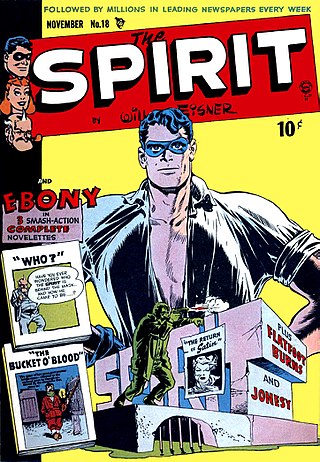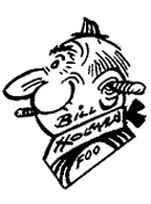
A comic strip is a sequence of cartoons, arranged in interrelated panels to display brief humor or form a narrative, often serialized, with text in balloons and captions. Traditionally, throughout the 20th and into the 21st century, these have been published in newspapers and magazines, with daily horizontal strips printed in black-and-white in newspapers, while Sunday papers offered longer sequences in special color comics sections. With the advent of the internet, online comic strips began to appear as webcomics.

Moon Mullins is an American comic strip which had a run as both a daily and Sunday feature from June 19, 1923 to June 2, 1991. Syndicated by the Chicago Tribune/New York News Syndicate, the strip depicts the lives of diverse lowbrow characters who reside at the Schmaltz boarding house. The central character, Moon, is a would-be prizefighter—perpetually strapped for cash but with a roguish appetite for vice and high living. Moon took a room in the boarding house at 1323 Wump Street in 1924 and never left, staying on for 67 years. The strip was created by cartoonist Frank Willard.

The Spirit is a fictional masked crimefighter created by cartoonist Will Eisner. He first appeared June 2, 1940, as the main feature of a 16-page, tabloid-sized, newsprint comic book insert distributed in the Sunday edition of Register and Tribune Syndicate newspapers; it was ultimately carried by 20 Sunday newspapers, with a combined circulation of five million copies during the 1940s. "The Spirit Section", as the insert was popularly known, continued until October 5, 1952. It generally included two other four-page strips, plus filler material. Eisner, the overall editor, wrote and drew most Spirit entries, with the uncredited assistance of his studio of assistants and collaborators, though with Eisner's singular vision a unifying factor.

King Features Syndicate, Inc. is an American content distribution and animation studio, consumer product licensing and print syndication company owned by Hearst Communications that distributes about 150 comic strips, newspaper columns, editorial cartoons, puzzles, and games to nearly 5,000 newspapers worldwide. King Features Syndicate also produces intellectual properties, develops new content and franchises, like The Cuphead Show!, which it produced with Netflix, and licenses its classic characters and properties. King Features Syndicate is a unit of Hearst Holdings, Inc., which combines the Hearst Corporation's cable-network partnerships, television programming and distribution activities, and syndication companies. King Features' affiliate syndicates are North America Syndicate and Cowles Syndicate.

Lawrence D. Lieber is an American comic book artist and writer best known as co-creator of the Marvel Comics superheroes Iron Man, Thor, and Ant-Man; for his long stint both writing and drawing the Marvel Western Rawhide Kid; and for illustrating the newspaper comic strip The Amazing Spider-Man from 1986 to September 2018. From 1974 to 1975, he was editor of Atlas/Seaboard Comics. Lieber is the younger brother of the late Marvel Comics writer, editor, and publisher Stan Lee.
Frank W. Bolle was an American comic-strip artist, comic book artist and illustrator, best known as the longtime artist of the newspaper strips Winnie Winkle and The Heart of Juliet Jones; for stints on the comic books Tim Holt and Doctor Solar, Man of the Atom; and as an illustrator for the Boy Scouts of America magazine Boys' Life for 18 years. With an unknown writer, he co-created the masked, Old West comic-book heroine the Black Phantom. Bolle sometimes used the pen name FWB and, at least once, F. L. Blake.
The Batman comic strip began on October 25, 1943, a few years after the creation of the comic book Batman. At first titled Batman and Robin, a later incarnation was shortened to Batman. The comic strip had three major and two minor runs in American newspapers.

The Sunday comics or Sunday strip is the comic strip section carried in most western newspapers. Compared to weekday comics, Sunday comics tend to be full pages and are in color. Many newspaper readers called this section the Sunday funnies, the funny papers or simply the funnies.
Stone Soup is an American newspaper comic strip. It was created by cartoonist Jan Eliot as Sister City, and was renamed after being syndicated by Universal Press Syndicate in 1995. The strip originally ran daily until 2015, when it switched to Sunday strips only before ending in 2020. The strip centers on a single mother named Valerie Stone, and her struggles to raise her daughters Alix and Holly.

Arnold Roth is an American cartoonist and illustrator for advertisements, album covers, books, magazines, and newspapers. Novelist John Updike wrote, "All cartoonists are geniuses, but Arnold Roth is especially so."

Everett M. Arnold, also known as Busy Arnold, was an American publisher and an early comic-book entrepreneur whose company Quality Comics published during the 1930s and 1940s period fans and historians call the Golden Age of Comic Books. He was also instrumental in the publishing arrangement that led to Will Eisner's newspaper Sunday-supplement comics series The Spirit.

Richard Church Thompson was an American illustrator and cartoonist best known for his syndicated comic strip Cul de Sac and the illustrated poem "Make the Pie Higher". He was given the Reuben Award for Outstanding Cartoonist of the Year for 2010.
Paul Leroy Norris was an American comic book artist best known as co-creator of the DC Comics superhero Aquaman, and for a 35-year run as artist of the newspaper comic strip Brick Bradford.
A comic strip syndicate functions as an agent for cartoonists and comic strip creators, placing the cartoons and strips in as many newspapers as possible on behalf of the artist. A syndicate can annually receive thousands of submissions, from which only two or three might be selected for representation. In some cases, the work will be owned by the syndicate as opposed to the creator. The Guinness World Record for the world's most syndicated strip belongs to Jim Davis' Garfield, which at that point (2002) appeared in 2,570 newspapers, with 263 million readers worldwide.

Bill Holman was an American cartoonist who drew the classic comic strip Smokey Stover from 1935 until he retired in 1973. Distributed through the Chicago Tribune syndicate, it had the longest run of any strip in the screwball genre. Holman signed some strips with the pseudonym Scat H. He once described himself as "always inclined to humor and acting silly."

Ferdinand Johnson, usually cited as Ferd Johnson, was an American cartoonist, best known for his 68-year stint on the Moon Mullins comic strip.

Penny was a comic strip about a teenage girl by Harry Haenigsen which maintained its popularity for almost three decades. It was distributed by the New York Herald Tribune Syndicate from June 27, 1943, to October 25, 1970.
The Register and Tribune Syndicate was a syndication service based in Des Moines, Iowa, that operated from 1922 to 1986, when it was acquired by King Features to become the Cowles Syndicate affiliate. At its peak, the Register and Tribune Syndicate offered newspapers some 60 to 75 features, including editorial cartoonist Herblock, comic strips, and commentaries by David Horowitz, Stanley Karnow, and others.
The New York Herald Tribune Syndicate was the syndication service of the New York Herald Tribune. Syndicating comic strips and newspaper columns, it operated from c. 1914 to 1966. The syndicate's most notable strips were Mr. and Mrs., Our Bill, Penny, Miss Peach, and B.C. Syndicated columns included Walter Lippmann's Today and Tomorrow, Weare Holbrook's Soundings, George Fielding Eliot's military affairs column, and John Crosby's radio and television column. Irita Bradford Van Doren was book review editor for a time.
Superman: The Complete Comic Strips 1939-1966 is an unofficial umbrella name for the six following titles: Superman: The Golden Age Dailies, Superman: The Golden Age Sundays; Superman: The Atomic Age Dailies, Superman: The Atomic Age Sundays; Superman: The Silver Age Dailies and Superman: The Silver Age Sundays, all published by The Library of American Comics. These six series of books collects the complete run of the American comic strip Superman by DC Comics, which was originally distributed in newspapers by the McClure Syndicate between 1939 and 1966.











